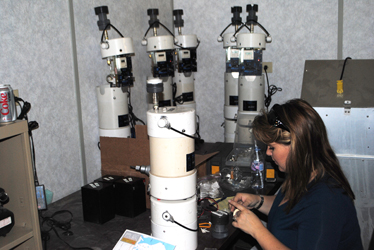Monitoring the environment at Giant Mine
Consistent monitoring and evaluation is integral to ensuring the safety of northerners and the environment at the Giant Mine site.
How is the site monitored now?

The Project team regularly monitors the site for health and safety reasons, and to inform the overall design of the remediation plan. They monitor air and water quality. This includes treated mine water discharged into Baker Creek, as well as other surface water and groundwater around the site.
An understanding of the risks associated with contaminants in the environment allows the team to be proactive in reducing those risks, and allows them to capture data to measure the success of the remediation plan.
The Health Effects Monitoring Program, a biological monitoring study, will also measure the plan's success.
Monitoring water on site
- Water from Baker Creek, the underground mine, and other locations around the site receives regular sampling and testing. The site samples are compared to reference locations, to allow the team to compare site samples to background conditions. Water samples are tested for many different contaminants including:
- arsenic
- cyanide
- other metals such as copper and nickel
Water going through the water treatment plant is collected from the underground mine for testing. This is done to check that the treatment system is working properly and water discharged into the receiving environment meets federal guidelines and former Water Licence limits.
Currently, treated water is discharged into Baker Creek during the summer and early fall. Water is also sampled at a number of different locations around the mine site. Results from these samples help determine the current levels of contamination and if conditions at the site are changing. These results help inform remediation decisions and will be used to monitor for improvements on site as the remediation proceeds.
Monitoring air on site
Air sample collection takes place in 22 locations, chosen based on prevailing winds and geography. Site features, such as the tailings ponds and former location of the roaster complex, are taken into account to ensure monitoring can determine the source of airborne contaminants, such as metals and arsenic.
Air monitoring mainly takes place during the field season, but can also take place if there is work ongoing into winter months. During this time, the air sample collection takes place during a period of 24 hours, every six days. The National Air Pollution Surveillance Network guidelines requires the collection of samples every 30 days.
More information our robust air quality monitoring program is available here.
How will the site be monitored during and after remediation?
A detailed plan for monitoring the site during and after remediation is under development. Community stakeholders are providing input.
The Long-term Monitoring Program (LTMP) will be an important part of the Project's environmental management. Components that will form part of long-term monitoring include:
- air quality
- vegetation
- wildlife and aquatic habitat
- water quality
- the freeze system
These components were defined as part of the Developer's Assessment Report and the creation of Environmental Management Plans.
Overall, the LTMP will:
- measure indicators and analyze the data to determine progress on the project's environmental objectives
- confirm indicators are appropriate
- apply adaptive management feedback to decision-making to continuously improve the project
Over the longer term, the LTMP will:
- help assess if the project is successful in meeting environmental objectives
- inform changes in site conditions and remediation measures are contributing to environmental improvement
- identify where further research or investigation is needed to meet environmental objectives